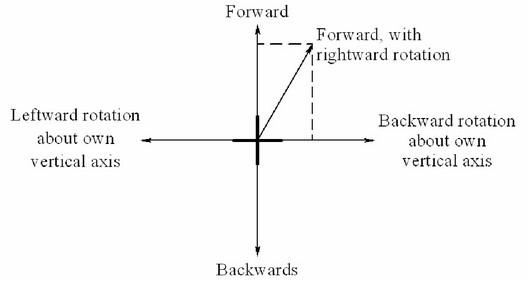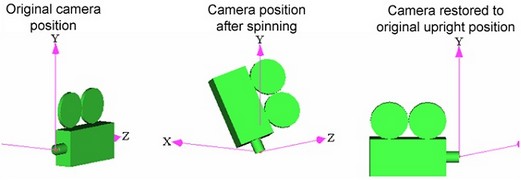Moving Camera



Moving Camera |
  
|
To watch the 3D scene via a moving camera, you need to make that camera active. The camera's motion within the 3D scene occurs in two modes:
1. Surveillance mode (spinning).
2. Translation/rotation mode.
You can watch the motion of the selected camera, that you have made active, from the system camera (in another window), by creating two 3D windows by the command "WSP: Split Window Vertically".
The motion of the user camera occurs only if the "Movable" flag is set among the camera's parameters, which means this parameter toggles the camera motion mode. Switching between these modes can be done manually or by the help of the command "3VG: Move Active Camera":
Icon |
Ribbon |
|---|---|
|
View → 3D Model → Move Camera |
Keyboard |
Textual Menu |
<3VG> |
View > Move Camera |
After calling the command, one of the camera's motion modes sets automatically. Usually, this is the mode that was used last in the previous command call.
Setting the "Walk mode" mode is done by the option:
![]() <W> Walk mode
<W> Walk mode
At the moment of picking this icon, the "Movable" flag automatically sets in the camera's parameters, resulting in the system switching to the respective mode.
To make the camera move, you need to select a reference center. To do this, point anywhere on the screen and click ![]() . A cross will appear on the screen that will become the reference center for the direction vector (the vectors are not displayed). The motion occurs in the following way: moving the pointer by the mouse with the button depressed upward from the cross moves the camera forward. Moving the pointer downward from the cross will move the camera backwards. Moving the pointer in the horizontal direction right or left of the cross will make the camera rotate about its vertical axis right or left, accordingly. Moving the pointer along a diagonal with horizontal and vertical components (see the diagram) will make the camera both move in the respective direction and rotate. Note that, depending on the pointer's bias to one or the other main vector, the translation or else the rotation will dominate to some degree. The farther the pointer is moved away from the cross, the faster the camera will move.
. A cross will appear on the screen that will become the reference center for the direction vector (the vectors are not displayed). The motion occurs in the following way: moving the pointer by the mouse with the button depressed upward from the cross moves the camera forward. Moving the pointer downward from the cross will move the camera backwards. Moving the pointer in the horizontal direction right or left of the cross will make the camera rotate about its vertical axis right or left, accordingly. Moving the pointer along a diagonal with horizontal and vertical components (see the diagram) will make the camera both move in the respective direction and rotate. Note that, depending on the pointer's bias to one or the other main vector, the translation or else the rotation will dominate to some degree. The farther the pointer is moved away from the cross, the faster the camera will move.
When moving the camera, it is convenient to simultaneously use the keyboard (see the chapter "Working with the 3D view window", the topic "Spinning 3D scene").

"Walk mode" enables "walking" around the current 3D scene. It is especially convenient when creating floor plans of buildings.
To set the "Surveillance (spinning)" mode of a user camera, use the option:
![]() <E> Surveillance (spinning)
<E> Surveillance (spinning)
This also terminates the walking mode.
Spinning a user camera means rotating the camera about to the rotation center that coincides with its fixing point and also the watching point. Besides that, spinning a user camera is done in the same way as spinning the system camera (see the chapter "Working with the 3D view window", the topic "Spinning 3D scene").
As the camera moves, the shift and rotation values relative to the camera's fixing coordinate system go through transformations. Also transformed are the parameters that were defined by variables or an expression. Those transformations are automatically recorded in the camera's transformation parameters upon exiting the command.
As long as the command is active, it is possible to quickly return the camera to its position before starting the command "Move Active Camera". The option used for this purpose is:
![]() <H> Reset Camera position
<H> Reset Camera position
As the 3D scene is surveyed by a spinning camera, situations may occur when you need to return the camera in the original upright position. The option provided for this purpose is:
![]() <V> Reset Camera vertical orientation
<V> Reset Camera vertical orientation
This option performs a one-time action. In this way, the values of the coordinates resulting from spinning the camera and setting its vertical position reset to the original values, which are those recorded as a result of the last call of the command parameters dialog box.

See also: Cameras